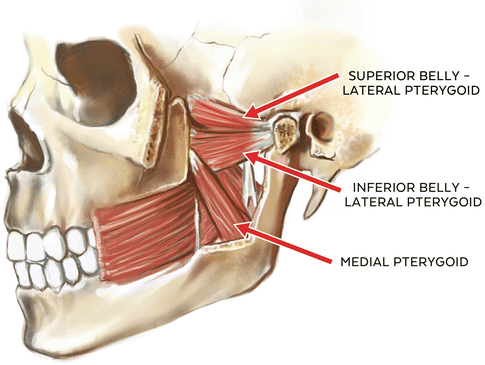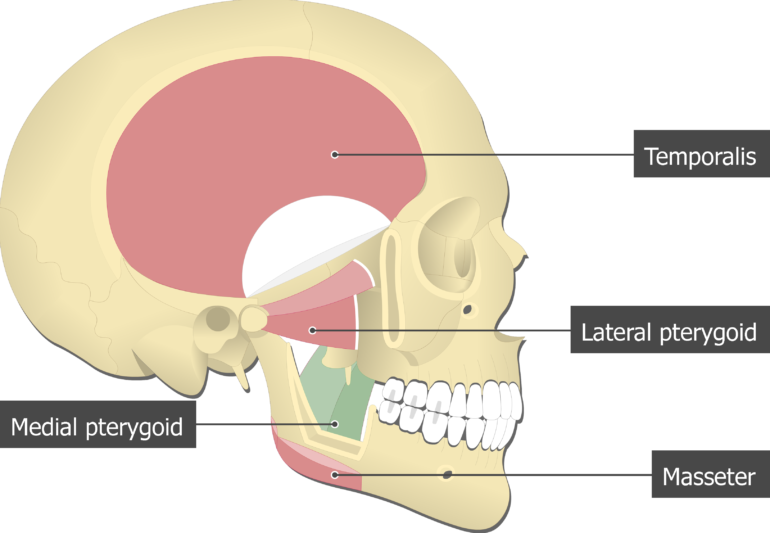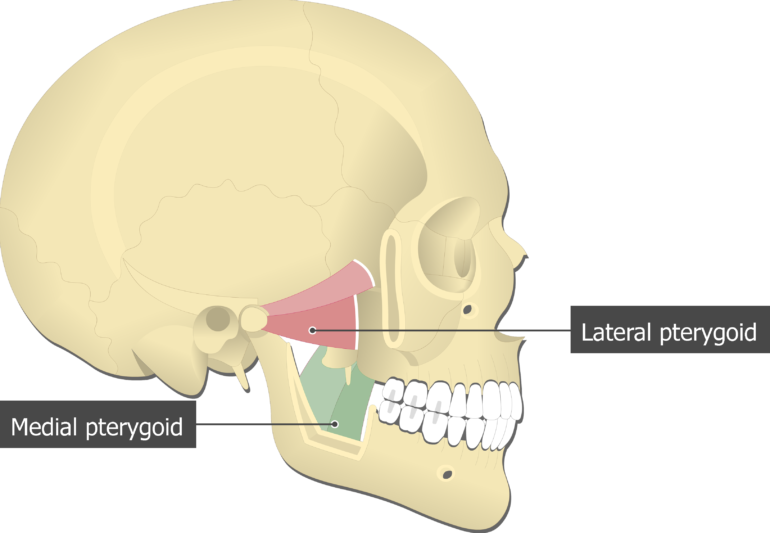The function of a muscle is usually associated with the part of the body to which the muscles attaches. The action occurs in synergy with contraction of the ipsilateral medial pterygoid muscle.
:background_color(FFFFFF):format(jpeg)/images/library/13050/4Q1NsvAE81JCSTJc7Tf0w_Pterygoideus_medialis_01.png)
Medial Pterygoid Origin Insertion Action Innervation Kenhub
They also protect the contents of the abdomen against injury and help support the body.

. Acting together with the lateral pterygoid muscles they protrude the mandible which is important in the grinding movement of mastication. The medial pterygoid muscle has a triple function. This combined muscle action swings the jaw to the opposite side and is seen for example when grinding food between the teeth on one side of the mouth.
Acting together with the lateral pterygoid muscles they protrude the mandible which is important in the grinding movement of mastication. The fibers of the medial pterygoid muscle run posterolaterally and insert to the medial surface of the mandibular ramus and angle. They move the mandible side to side.
Where are the Pterygoids. The medial pterygoid acts together with masseter to elevate the mandible. By contracting on one side the medial pterygoid pushes the mandible to the opposite side.
From these origins muscle fibres pass inferiorly laterally and posteriorly. Use your time efficiently and maximize your retention of key facts and definitions with study sets created by other students studying Medial Pterygoid Muscle Action. The bilateral contraction of this muscle elevates the mandible and closes the mouth.
Elevates mandible closes jaw helps lateral pterygoids in moving the jaw from side to side. They insert into the medial surface of the angle of the mandible posterior to the mylohyoid groove. Medial Pterygoid OriginSuperficial head.
Muscle musl a bundle of long slender cells muscle fibers that have the power to contract and hence to produce movement. From medial surface of lateral pterygoid plate adjoining pro. Muscle function is suggested as a discriminating action rein-like in nature probably corresponding to Bennett movement.
Elevation of the mandible. Since the medial pterygoid muscle attaches to the lower jaw the function of this muscle is to move the lower jaw. The medial pterygoid muscle attaches to the angle of the mandible and to the lateral pterygoid plate to form a sling with the masseter muscle that suspends the mandible Figure 6-19.
It has a second slip of origin. Learn about the origin insertion functions and innervation of the medial pter. The medial pterygoid is a thick quadrilateral muscle.
The medial pterygoid muscle a major elevator of the jaw is a square-shaped masticatory muscle located on the medial aspect of the lower jaw bilaterally. The masseter muscle is the most powerful muscle of mastication. This muscle lies medial to the lateral pterygoid muscle.
The contraction of the medial pterygoid elevates the mandible jaw closure and moves it forward protrusion. Innervation is from the nerve to medial pterygoid a branch of the mandibular nerve Vc. The medial pterygoid acts together with masseter to elevate the mandible.
The pterygoid muscles are the two jaw. Learn the facial muscles easily with these quizzes and labeled diagrams. The medial pterygoid muscle is innervated by the medial pterygoid branch of the mandibular division of the trigeminal nerve CN V3.
Mandibular nerve via nerve to medial pterygoid. Portable and easy to use Medial Pterygoid Muscle Action study sets help you review the information and examples you need to succeed in the time you have available. It is also known as internal pterygoid muscle.
The action of the muscle during bilateral contraction of the entire muscle is to elevate the mandible raising the lower jaw. The medial pterygoid muscle attaches to the angle of the mandible and to the lateral pterygoid plate to form a sling with the masseter muscle that suspends the mandible Figure 6-19. This muscle also contributes to the elevation of the mandible acting as a synergist to the temporalis and masseter.
Upon bilateral contractions the medial pterygoid muscles push the mandible forward protrude the mandible. Elevation of the mandible occurs during the closing of the jaws. Protract or protrude mandible.
First bilateral contraction of the muscle with lateral pterygoid muscle results in protrusion of the mandible1 This action results as the muscle fibers are aligned anteroposteriorly1. It receives blood supply from the pterygoid branches of the maxillary artery. Specifically the medial pterygoid muscle functions to.
What is the action of the masseter muscle. It can assist in protrusion of the mandible. Raiseelevate the lower jaw.
The primary action is to elevate the mandible and laterally deviate it to the opposite side. Muscles are responsible for locomotion and play an important part in performing vital body functions. It arises from the medial surface of the lateral pterygoid plate and the grooved surface of the pyramidal process of the palatine bone.
From tuberosity of maxilla adjoining boneDeep head. Medial pterygoid has several actions. The superficial part originates from maxillary process of the zygomatic bone.
The medial pterygoid muscle is one of the four paired muscles of mastication. The entirety of the muscle lies superficially to the pterygoids and temporalis covering them. Protract or protrude mandible.
See appendix 3-4 and see color plates. Actions of Lateral Pterygoid Muscle on the mandible. Actions of Medial Pterygoid Muscle on the mandible.
It is quadrangular in shape and has two parts. The arterial supply to medial pterygoid muscle is from the pterygoid branches of the maxillary artery. The primary action is to elevate the mandible and laterally deviate it to the opposite side.
Independent innervation arises from the medial surface of the mandibular nerve trunk just below the foramen ovale and enters the accessory medial pterygoid lateral surface at about the upper third centrally. Simplify your pterygoid muscle studies with this time-saving anatomy reference chart for the muscles of the head and neck. Dont forget to quiz yourself on the lateral pterygoid and other masticatory muscles to consolidate your knowledge.
Specifically the medial pterygoid muscle functions to. Since the medial pterygoid muscle attaches to the lower jaw the function of this muscle is to move the lower jaw. Second unilateral contraction of the medial pterygoid muscle with lateral pterygoid muscle ipsilaterally results in lateral movement of the.
The medial pterygoid muscle has a triple function.

Medial Pterygoid Muscle Origin Insertion Function Nerve Supply Anatomy Kenhub Youtube

Medial Pterygoid Muscle Attachments Actions Innervation

Medial Pterygoid Muscle Attachments Actions Innervation

Static And Functional Anatomy Of The Human Masticatory System Pocket Dentistry

Image Result For Pterygoid Muscle Human Anatomy And Physiology Dental Anatomy Muscle Anatomy

Medial Pterygoid Muscle Attachments Actions Innervation

Medial Pterygoid Muscle Wikipedia
:background_color(FFFFFF):format(jpeg)/images/library/14110/Pterygoid_muscles.png)
Medial And Lateral Pterygoid Muscle Anatomy And Function Kenhub
0 comments
Post a Comment